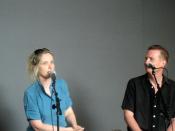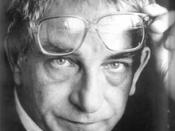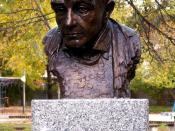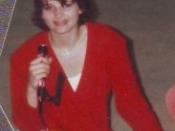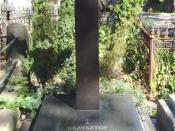The Three Colours Trilogy by Krzysztof Kieà Âlowski, is based on the three ideals of the French Revolution: Liberté, Egalite and Fraternité. Kieà Âlowski looked to examine these themes on an individual, personal level rather than as a broad, remote notion. As he explained to writer and translator Danusia Stok, the guiding principal behind the trilogy is how the three words liberty, equality and freedom function today "on a very human, intimate and personal plane and not on a philosophical let alone political or social one." The first of the films, Blue deals with Liberté, or Freedom. It follows the story of Julie (Juliette Binoche), a woman thrown into a new state of consciousness by family tragedy. It is a delicate and introspective study of loss and a lucid examination of a woman's state of mind.[2: Danusia Stock (ed), Kieà Âlowski on Kieà Âlowski, London; Faber and Faber, 1993 p212]
Julie loses her husband Patrice, a well known composer and her young daughter Anna in an automobile accident.
After a spell in hospital and a failed suicide attempt Julie makes the conscious decision to gain 'freedom' from painful memories and nostalgia of her past life by severing all ties to it. Julie sell of her country estate and all her possessions (except for her daughter's blue mobile), and moves to a Paris apartment in an attempt to get lost in the anonymity of the big city. Julie not only cuts herself free from her past but also avoids making new relationships; she speaks only for practical purposes and steers clear of everything that doesn't concern her directly. She attempts to live a purely functional existence devoid of emotion. However Julie soon discovers that the 'freedom' she seeks is not easy to achieve. Olivier (Benoit Regent), a friend of Patrice and a fellow composer, has been in love with Julie for many years. Having succumb to Julie's sexual advances soon after the crash he is not content to let her go. While this encounter for Julie was for her a 'purging' of her old life rather than anything sexual or emotional she slowly, as the film progresses, warms to Olivier. There is also Lucille her neighbour. Lucille is a prostitute and ostracised by her other neighbours. When Julie refuses to sign a petition to have her removed from the building because it is 'not her problem', Lucille is grateful and forcibly imposes her friendship upon Julie. Not only does Lucille comfort Julie but, perhaps more importantly, she forces Julie to comfort her.
Perhaps the most significant connection to her past is her late husband's composition. Previous to his death Patrice de Courcey was commissioned to write a piece for the Unification of Europe. Patrice's untimely death inflamed public interest in the piece that Julie finds increasingly difficult to run away from. Although Julie tries to destroy the composition, copies had been made and Olivier is brought in to finish it. It is alluded to in the film that Julie herself may have played a big part in Patrice's compositions, even that she herself may have written them. Julie is eventually forced to confront the music and all the memories it brings and it is this that eventually drags Julie out of her self-imposed emotional exile. Zbignew Preisner's score is also central to establishing the verisimilitude of Julie's high art background and her late husband's stature.
K personifies a complete freedom from memory in the form of Julie's mother. Julie's mother has Alzheimer's, and represents the extreme of any attempt to be free of memories, being unable to recall most details of her life. However it becomes clear that she has been deprived of her past rather than having been freed from it. She is shown to live a fruitless existence 'seeing the world' through her television screen yet not having a part in it. She has become isolated in her own world, an observer rather than a participant in life. It becomes clear at this point that Julie has not achieved what she has set out to do. Julie's expression is rarely vacant like her mothers; there always lingers the traces of emotion in the quivering of her lip or tears welling in her eyes. Like the bungee jumper on her mother's television screen, Julie is trying to free-fall but there is a cord that keeps attached inexorably to life.
The most obvious use of visual motif in the film is the use of the colour blue. Blue filters are used in many scenes when Julie is alone. Blue, of course, is symbolic of grief and mourning. When Julie is at her most introspective the blue deepens such as during her frequent swims in the pool. However its significance mutates during the course of the film to become a representation of hope and optimism.
Another discernible technique used in the film is Julie's blackouts. These occur when Julie is unable to suppress her memories. They occur in five instances, while at the hospital, at her meeting with Antoine, when she is locked out of her apartment, in the swimming pool and when she learns of Patrice's affair. Unlike the traditional fade to black, these blackouts arise in the middle of a scene rather than at the end and of course fade to blue rather black. Accompanied by de Courcey's motif they are dramatic, loud and sudden, jolting the viewer as they do Julie. They are representative of a powerful incursion of memory and loss as Julie's control slips and as she regains it.
Kieà Âlowski also explores how fate/destiny or chance affect our lives and the foreshadowing of events to come. At the beginning of the film Julie's car crashes into the sole tree on a deserted plane, at the precise moment a hitchhiker succeeds at a game he may have been attempting for hours. Olivier at the beginning of the film offers her Patrice's photographs. She refuses but sees them by chance anyway later in the film. It seems the choice is not made when Julie refuses the photographs merely delayed. Is this fate? Can a person ever be truly free if their life is already pre-destined?
The scene with the old lady struggling to put a bottle in a recycling bin is used in all three films. How the characters react to her reflect on the themes of the films. Instead of giving up on life she has accepted age and the life she has been given and she is still fulfilling her social responsibilities. Julie has her eyes closed the whole time and does not see this lady, perhaps signifying Julie is not yet ready for this truth, she is still blind to it.
There are several key close-ups in Blue, most memorably Julie soaking up her coffee with a sugar cube. In an interview with Kieà Âlowski he is explicit on the importance of these segments:
"We are trying to show how the heroine perceives the world. We are trying to show that she focuses on small things, on things that are close to her. She doesn't care about things which are further away from her. She is trying to limit her world, to limit it to herself and her immediate environment."[3: KIEÃ ÂLOWSKI, Krzysztof, Interview. In: Three Colours: Blue DVD, Artificial Eye, 2001 ]
Instead of liberating herself Julie is actually puts constraints on herself. In an attempt to protect herself she actually sacrifices her freedom. It could be argued that the process of what Julie is going through is the exact opposite of what is superficially occurring. Speaking about the part Juliette Binoche said "When you have lost everything, life is nothing". However as the film progresses it becomes increasingly apparent that Julie has not lost everything. Olivier still loves her unconditionally and although at the beginning of the film she tries to destroy everything from her past life, she keeps the blue mobile, a most poignant reminder of her loss. Although she thinks she has destroyed her husband's final composition she keeps the motif (the few notes that come flooding back to her during her blackouts) in her handbag. At the pool she submerges herself and curls up in a foetal position in an attempt to hold back her memories but yet goes back to her apartment and looks at the blue mobile. It seems the two elements of her former life that she is incapable of letting go of are her daughter and her husband's (or quite possibly her own) music. These are what lure her back into society. She realises her plan to rid herself of her memories and responsibilities has been futile. Her maternal instinct at no point diminishes, as is shown in her sympathy towards the rats and her relationship with her neighbour, the child-like Lucille. It is something she cannot be free of. When she offers her house and her husband's family name to her husband's mistress she is providing for Anna's half brother. If we assume that it was Julie who was the composer, when Patrice died she lost the mediator for her creativity, she did not however lose creativity itself. The completion of the Song for the Unification of Europe is the moment that finally brings her peace and allows her to accept her past and move on with hope. This is when Julie finally becomes free.[4: BINOCHE, Julie, Interview. In: Three Colours: Blue DVD, Artificial Eye, 2001 ]
